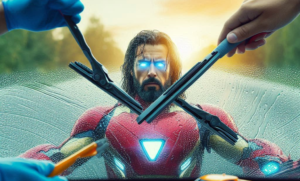Have you ever wondered how your car knows what the temperature is outside? It’s not magic – your car is actually equipped with a temperature sensor that measures the air temperature and sends that information to the car’s computer. This information is used for a variety of purposes, including controlling the climate control system, adjusting the engine performance, and displaying the temperature on the dashboard.
In this blog post, we will discuss how car temperature sensors work, the different types of sensors that are used, and the factors that can affect the accuracy of the temperature reading. We will also provide tips on how to improve the accuracy of your car’s temperature sensor and how to troubleshoot a faulty sensor. Whether you are a curious car enthusiast or a professional mechanic, this blog post will teach you everything you need to know about car temperature sensors.
Types of Temperature Sensors
Thermistors and resistance temperature detectors (RTDs) are the two primary types of temperature sensors found in automobiles.
- Thermistors: A semiconductor material used to make thermo resistors alters its electrical resistance in response to temperature variations. An increase in temperature causes a thermistor’s resistance to decrease. A thermistor’s resistance rises with decreasing temperature.
- RTDs: An electrical resistance-varying metal wire, used in RTDs, reacts to temperature variations. An RTD experiences an increase in resistance as temperature rises. An RTD experiences a drop in resistance when the temperature drops.
The temperature sensor is typically located behind the front grille, near the bottom of the car. This location is chosen because it is relatively protected from direct sunlight and wind, which can affect the accuracy of the temperature reading.
How the temperature sensor works?
The temperature sensor sends a signal to the car’s computer that corresponds to the current temperature. The car’s computer then uses this information to control the climate control system, adjust the engine performance, and display the temperature on the dashboard.
Accuracy of the temperature sensor
The accuracy of the temperature sensor can be affected by a number of factors, including:
- Location of the sensor: As mentioned above, the temperature sensor is typically located behind the front grille, near the bottom of the car. This location is chosen because it is relatively protected from direct sunlight and wind, which can affect the accuracy of the temperature reading. However, the sensor can still be affected by heat from the engine or from the road, especially on a hot day.
- Speed of the car: The speed of the car can also affect the accuracy of the temperature reading. When the car is moving at high speed, the air flowing over the sensor can cool it down, resulting in a lower temperature reading.
If you think your car’s temperature sensor is inaccurate, there are a few things you can do:
- Park in the shade: If possible, park your car in the shade to prevent the temperature sensor from being heated up by direct sunlight.
- Clean the sensor: If the temperature sensor is dirty, it can affect the accuracy of the reading. Clean the sensor regularly with a mild soap and water solution.
- Calibrate the sensor: If you think your car’s temperature sensor is inaccurate, you can have it calibrated by a professional mechanic.
If the sensor is damaged, it will need to be replaced.
What is thermistor? does car have thermometer to measure temperature?
Cars typically have a thermistor, not a thermometer. A thermistor is a type of temperature sensor that changes its electrical resistance in response to changes in temperature. When the temperature increases, the resistance of a thermistor decreases. When the temperature decreases, the resistance of a thermistor increases.
A thermometer, on the other hand, is a device that measures temperature by the expansion and contraction of a liquid or gas. Thermistors are preferred in cars because they are more accurate and durable than thermometers. They are also smaller and lighter, which is important for saving space and weight in a car.
How accurate are car outside temperature readings?
The accuracy of a thermistor depends on a number of factors, including the quality of the thermistor, the calibration of the thermistor, and the environmental conditions in which the thermistor is used.
Car temperature sensors are typically calibrated to be accurate within a few degrees Fahrenheit. However, it is important to keep in mind that the accuracy of the sensor can be affected by a number of factors, including:
- Location of the sensor: The temperature sensor in a car is typically located behind the front grille, near the bottom of the car. This location is chosen because it is relatively protected from direct sunlight and wind, which can affect the accuracy of the temperature reading. However, the sensor can still be affected by heat from the engine or from the road, especially on a hot day.
- Speed of the car: The speed of the car can also affect the accuracy of the temperature reading. When the car is moving at high speed, the air flowing over the sensor can cool it down, resulting in a lower temperature reading.
- Weather conditions: Extreme weather conditions, such as heavy rain or snow, can also affect the accuracy of the temperature reading.
- Air around it: If the too cold or too hot air around temperature sensor than results will not accurate.
In general, car temperature sensors are accurate enough for most purposes. However, if you need a highly accurate temperature reading, you should use a dedicated temperature sensor designed for that purpose.
How do I know if my car temperature sensor is bad?
There are a few signs that your car temperature sensor may be bad:
- The temperature gauge on your dashboard is inaccurate. If the temperature gauge is reading higher or lower than what you would expect, it could be a sign that the sensor is not working properly.
- The check engine light is on. There may be a problem with the temperature monitor or another part of the engine cooling system if the check engine light is on.
- The engine is overheating. If your engine is overheating, it could be a sign that the temperature sensor is not working properly and is not sending the correct signal to the engine computer.
- The cooling fan is running constantly. If the cooling fan is running constantly, even when the engine is not hot, it could be a sign that the temperature sensor is not working properly and is sending a false signal to the engine computer.
Can I drive my car without temperature sensor?
It is technically possible to drive your car without a temperature sensor, but it is not recommended. The temperature sensor is an important part of the engine cooling system, and it plays a vital role in preventing the engine from overheating.
Without a temperature sensor, the engine computer will not be able to accurately monitor the engine temperature and adjust the engine parameters accordingly.
What happens when a temperature sensor fails?
When a temperature sensor fails, it can cause a number of problems, including:
- Engine overheating.
- Reduced fuel efficiency.
- Poor performance.
- Check engine light.
- The car may not start.
- The car may run poorly.
- The car may stall.
- The car may idle roughly.
- The car may have poor fuel economy.
- The car may emit excessive emissions.
If you suspect that your car’s temperature sensor is bad, it is important to have it checked by a qualified mechanic as soon as possible. A faulty temperature sensor can cause serious damage to your car’s engine.
Why my Car outside temperature gauge reading high or low?
Because of where the sensor is located, the speed of the car, the weather, or a broken sensor, the outside temperature gauge of a car may show a high or low reading. To get a more accurate reading of the temperature, park in the shade, clean the monitor, and, if necessary, bring it up to date. The monitor might need to be changed if the gauge is still off.
How to reset outside temperature gauge in car?
Change the outside temperature gauge in a car in a few different ways, based on the type of car you have.
This is a general process that might work for most cars:
- Stop the car.
- Take the negative battery wire off.
- We need you to wait 30 minutes.
- Connect the negative end of the battery again.
- Start the car.
Now you should be able to reset the outside temperature gauge.
What causes the car temperature to change, even when the outside temperature stays the same?
The car temperature can vary as compared to the outside temperature due to a number of factors, including the location of the temperature sensor, the speed of the car, weather conditions, solar radiation, the greenhouse effect, the number of passengers, and the use of air conditioning.
To keep your car cool in hot weather, park in the shade, use the air conditioning, roll down the windows to ventilate the car before getting in, cover the windshield and dashboard with a sun visor, and keep a bottle of water in the car so you can stay hydrated.
How to improve the accuracy of the temperature sensor?
To get the temperature sensor in your car to work better, you can do the following:
- Park in the shade: If you can, park your car in the shade so that strong sunlight doesn’t heat up the temperature sensor. This is very important when it’s hot outside.
- Clean the sensor: If the temperature sensor is dirty, the reading might not be accurate. Use a gentle soap and water solution to clean the sensor often.
- Calibrate the sensor: If you think the temperature sensor in your car isn’t working right, you can have a trained mechanic calibrate it. To do this, the reading from the sensor must be compared to a known accurate source of temperature and the sensor must be adjusted properly.
Here are some more helpful Tips to accurate your car temperature sensor:
- Don’t park near hot things: Don’t park your car near hot things like an engine block or an exhaust pipe. This could make the temperature sensor hot, which would give you a wrong number.
- Check the wires on the sensor: Check to see if the wiring for the temperature gauge is in good shape and that no connections are coming loose.
- Have the sensor replaced if it is damaged: If the sensor is broken, get a new one: The temperature monitor will need to be changed if it is broken. A skilled tech should be able to do this.
If you follow these tips, you can help to ensure that your car’s temperature sensor is accurate and providing you with reliable information.
What are the temperature sensors used in automobile industry?
Emerging trends in automotive temperature sensing technology include:
- Air conditioning that is controlled by AI: These systems use AI to learn what temperature the driver likes and then change the air conditioning system to match. This could make driving more comfortable and tailored to your needs.
- Adaptive temperature control systems: Adaptive temperature control systems use sensors to monitor the temperature of the cabin and the occupants, and then adjust the climate control system accordingly. This can help to ensure that the cabin is always at a comfortable temperature, even if the outside temperature changes.
- Advanced temperature sensors: New temperature sensors are being developed that are more accurate, durable, and smaller than traditional sensors. This could lead to new applications for temperature sensors in cars, such as monitoring the temperature of the engine components or the brakes.
Here are some specific examples of how these emerging technologies are being used in cars today:
- BMW’s Personal Co-Pilot: BMW’s Personal Co-Pilot is an AI-driven climate control system that learns the driver’s temperature preferences and adjusts the climate control system accordingly. The system also takes into account factors such as the outside temperature, the sun’s position, and the driver’s seat position.
- Mercedes-Benz’s ENERGIZING Comfort system: Mercedes-Benz’s ENERGIZING Comfort system is an adaptive temperature control system that uses sensors to monitor the temperature of the cabin and the occupants, and then adjusts the climate control system accordingly. The system also includes other features, such as aromatherapy and massage, to create a relaxing and comfortable driving experience.
- Continental’s temperature sensors: Continental is developing new temperature sensors that are more accurate, durable, and smaller than traditional sensors. These sensors could be used to monitor the temperature of the engine components, the brakes, or even the interior of the car.
These are just a few examples of the emerging trends in automotive temperature sensing technology. As these technologies continue to develop, we can expect to see even more innovative and useful applications in the future.
Conclusion
The temperature sensor in your car is an important part of the climate control system. By understanding how the sensor works and the factors that can affect its accuracy, you can ensure that you are getting the most accurate temperature readings possible. You can learn about types of sensors and how it works, Emerging trends in automotive temperature sensing technology.
FAQs about car temperature sensors
Q: Is the temperature sensor in a car accurate?
The temperature sensor in a car is generally accurate, but it can be affected by a number of factors, such as the location of the sensor, the speed of the car, and the weather conditions.
Q: Why is my car’s temperature sensor reading high?
There are a few reasons why your car’s temperature sensor might be reading high. One reason is that the sensor may be located near the engine or the road, which can cause it to heat up. Another reason is that the sensor may be dirty. Finally, the sensor may be out of calibration.
Q: How do I fix my car’s temperature sensor?
If you think your car’s temperature sensor is inaccurate, you can try cleaning it or having it calibrated by a professional mechanic. If the sensor is damaged, it will need to be replaced.








